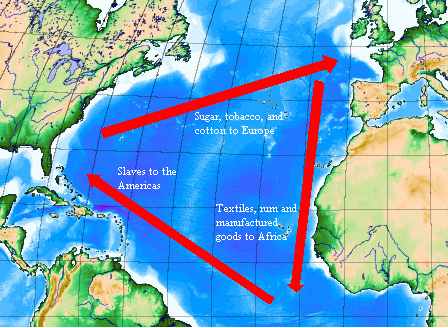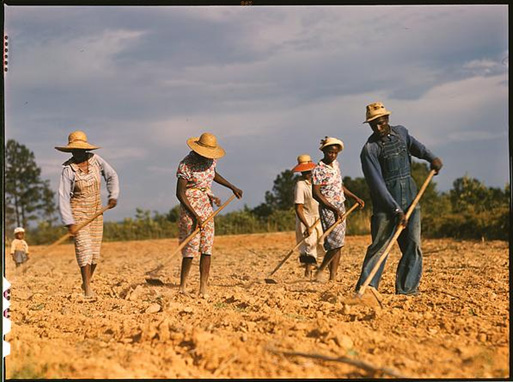
Source: Triangle Trade 2, Simon P, Wikipedia
The map below illustrates the slave trade that brought African slaves, by force, to the United States.

Source: Triangle Trade 2, Simon P, Wikipedia

![]() Click here to access an interactive map of the Triangular Trade Routes.
Click here to access an interactive map of the Triangular Trade Routes.
Beginning with the arrival of the first slaves in Jamestown, Virginia, in 1619, more than 20 million slaves left Africa with nearly 500,000 of them making their way to the United States. African slaves were imported to the United States through the slave trade. Between 1619 and 1865, the number of slaves had reached nearly 4 million.
According to the 1790 census, people of African origin accounted for 20 percent of the population. Immigration from Africa steadily declined thereafter.

Source: US slave Free 1789-1861
After slavery ended, blacks in the South found it difficult to live in the region where they were once held in captivity. The economic and social conditions in the South were intolerable. Economically, blacks were unable to find jobs or buy land. Sharecropping quickly became a necessary way of life for many freed blacks. This system of blacks living on the land of white farmers or landowners in exchange for tending the crops kept southern blacks indebted to the landowner. Sadly, most of the time, the sharecroppers did not make a profit, which caused them to go further and further into debt. See the diagram below for more details.

The image below is of a family of sharecroppers in White Plains, Georgia.

Source: Chopping cotton on rented land near White Plains, Greene County, Ga., Jack Delano,
Library of Congress.
Socially, blacks in the South were denied the rights that whites enjoyed. They were denied equal education and other public services, and they were treated as second-class citizens.
In the search for an opportunity for a better life, many blacks migrated from the rural south to various urban centers in the North. This was called the Great Migration.
According to the map, which region did most blacks from the South migrate to?
Interactive popup. Assistance may be required. Most migrated to the Northeast.
Much like the first wave of European immigrants and those who later immigrated during the Industrial Revolution, blacks who migrated from the South brought with them their beliefs, customs, and other components of their culture to their new homes. The population of cities such as New York City, Chicago, and Detroit now included growing numbers of black citizens.
Although they believed they would experience better living conditions and better wages, many blacks found similar situations of unequal pay and discrimination when they arrived to these major cities. Many conflicts stemmed from the competition for jobs and an adequate living between migrants and immigrants in these major cities.